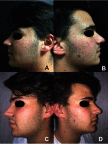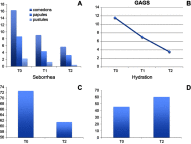Clinical evidence on the efficacy and tolerability of a topical medical device containing benzoylperoxide 4%, retinol 0.5%, mandelic acid 1% and lactobionic acid 1% in the treatment of mild facial acne: an open label pilot study
- PMID: 31190944
- PMCID: PMC6526677
- DOI: 10.2147/CCID.S182317
Clinical evidence on the efficacy and tolerability of a topical medical device containing benzoylperoxide 4%, retinol 0.5%, mandelic acid 1% and lactobionic acid 1% in the treatment of mild facial acne: an open label pilot study
Abstract
Background: Acne is a debilitating disorder that requires proper treatment depending on the clinical manifestations and pathogenetic factors, among which hyper-keratinization, seborrhea and bacterial proliferation. Combining active ingredients targeting the different mediators of acne pathogenesis may yield optimal outcomes. Purpose: The purpose of this study was to evaluate the clinical effectiveness, safety and tolerability of a new topical medical device in cream containing benzoylperoxide 4%, pure retinol 0.05%, palmitate retinol 0.5%, mandelic acid 1% and glycyrrhetic acid on patients with mild acne. Patients and methods: Twenty consecutive patients of both sexes with mild acne were included in the study. The topical treatment was self-applied twice a day for 12 weeks. Evaluations included: Global Acne Grading System (GAGS); inflammatory and non-inflammatory lesions count; reflectance confocal microscopy; seborrhea and hydration degree; photographic documentation; a questionnaire to assess tolerability. Results: The GAGS score showed a 39% reduction from T0 to T1 and 69.20% from T0 to T2. The count of comedonic lesions showed a 44% reduction from T0 to T1 and 65% from T0 to T2. The count of papular lesions diminished by 49.4% from T0 to T1 and by 62% from T0 to T2. The count of pustular lesions decreased by 43% from T0 to T1 and by 80% from T0 to T2. Improvement of hydration and a decrease of seborrhea degree were even observed. These clinical results were confirmed by reflectance confocal microscopy exam. Conclusion: The topical medical device has shown to be clinically effective and well tolerated for the treatment of mild acne. Side effects were mild, transient and well tolerated. The results of our study demonstrated a high tolerability of this new combination of benzoylperoxide 4% and retinol. Furthermore, our results suggested that the studied compound could be considered as a "maintenance treatment" after specific pharmacological treatment, even in more severe types of acne.
Keywords: acne vulgaris; alpha hydroxide acid; benzoyl peroxide; therapeutics; vitamin A.
Conflict of interest statement
This is a sponsor free trial. The authors report no conflicts of interest in this work.
Figures



Similar articles
-
Efficacy and tolerability of a topical gel containing 3% hydrogen peroxide, 1.5% salicylic acid and 4% D-panthenol in the treatment of mild-moderate acne.G Ital Dermatol Venereol. 2016 Jun;151(3):287-91. Epub 2016 Jan 13. G Ital Dermatol Venereol. 2016. PMID: 26761768
-
Efficacy and Tolerability of a Combined 445nm and 630nm Over-the-counter Light Therapy Mask with and without Topical Salicylic Acid versus Topical Benzoyl Peroxide for the Treatment of Mild-to-moderate Acne Vulgaris.J Clin Aesthet Dermatol. 2016 Mar;9(3):25-35. Epub 2016 Mar 1. J Clin Aesthet Dermatol. 2016. PMID: 27354885 Free PMC article.
-
Randomised controlled multiple treatment comparison to provide a cost-effectiveness rationale for the selection of antimicrobial therapy in acne.Health Technol Assess. 2005 Jan;9(1):iii-212. doi: 10.3310/hta9010. Health Technol Assess. 2005. PMID: 15588555 Clinical Trial.
-
Clindamycin/benzoyl peroxide gel: a review of its use in the management of acne.Am J Clin Dermatol. 2002;3(5):349-60. doi: 10.2165/00128071-200203050-00007. Am J Clin Dermatol. 2002. PMID: 12069641 Review.
-
Adapalene 0.1%/benzoyl peroxide 2.5% gel: a review of its use in the treatment of acne vulgaris in patients aged ≥ 12 years.Am J Clin Dermatol. 2011 Dec 1;12(6):407-20. doi: 10.2165/11208170-000000000-00000. Am J Clin Dermatol. 2011. PMID: 21967116 Review.
Cited by
-
Tailoring of Retinyl Palmitate-Based Ethosomal Hydrogel as a Novel Nanoplatform for Acne Vulgaris Management: Fabrication, Optimization, and Clinical Evaluation Employing a Split-Face Comparative Study.Int J Nanomedicine. 2021 Jun 24;16:4251-4276. doi: 10.2147/IJN.S301597. eCollection 2021. Int J Nanomedicine. 2021. PMID: 34211271 Free PMC article.
-
Characterization of Acne-Prone Skin with Reflectance Confocal Microscopy and Optical Coherence Tomography and Modifications Induced by Topical Treatment and Probiotic Supplementation.J Clin Med. 2023 Jul 20;12(14):4787. doi: 10.3390/jcm12144787. J Clin Med. 2023. PMID: 37510902 Free PMC article.
-
Dermoscopy, Reflectance Confocal Microscopy and Optical Coherence Tomography Features of Acne: A Systematic Review.J Clin Med. 2022 Mar 24;11(7):1783. doi: 10.3390/jcm11071783. J Clin Med. 2022. PMID: 35407391 Free PMC article. Review.
-
Enhanced Tolerability and Improved Outcomes in Acne Management: A Real-World Study of Dermocosmetic Adjunctive Therapy.J Cosmet Dermatol. 2025 Jan;24(1):e16772. doi: 10.1111/jocd.16772. J Cosmet Dermatol. 2025. PMID: 39757973 Free PMC article.
References
LinkOut - more resources
Full Text Sources
Other Literature Sources

